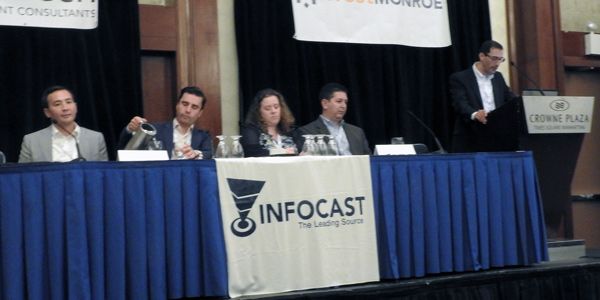By Michael Kuser
NEW YORK — New York’s grid is transitioning from a one-way transmission system to a multidirectional one, and utilities still need time to develop the analytical tools to understand how to deal with distributed energy resources.
That was the assessment of panelists speaking at the Infocast New York Energy REVolution Summit held last week at Times Square.
“We are at a very early stage of bringing DERs into what has historically been a passive distribution system,” NYISO Senior Manager for Market Design Michael DeSocio said during a panel on the ISO’s DER Roadmap, which outlines the grid operator’s plans for integrating DER into its ancillary services, capacity and energy markets over the next five years.
“We want to get to a 21st-century grid, but we’re still running 20th-century computer systems. We’re still running 20th-century metering,” DeSocio said.
Natara G. Feller of Feller Law Group posed some of the main questions on the topic: “In NYISO’s bulk transmission system versus Con Ed’s distribution system, how do DER resources impact reliability? How can we shave the peak off the grid? How does this impact the state’s requirement for meeting certain capacity standards? What kind of obligations are consumers going to assume, or are they passive obligations where they’re not assuming responsibility?”
Deployment First?

“Are we going to have deployment first, or the markets first?” asked Chris Rauscher, director of public policy at Sunrun, the country’s largest rooftop solar company. “As my company and others deploy more storage paired with PVs, are we going to do that in states that already have open access to markets, or are we going to other states that have incentives, for example? And how do we sync all this up together?”
Ben Pickard, a distributed energy analyst at National Grid Ventures, which has a strategic partnership with Sunrun, said the development of a DER roadmap comes with the risk that ISO will “overbuild and structure for every contingency at the expense of just trying to get markets going.”
DeSocio responded that distribution systems must evolve because they haven’t necessarily been designed to deal with all the traffic they will handle with increased DER adoption. The ISO will need enough information to determine whether its own actions create a reliability issue for utilities, which — in turn — are trying to learn how to spot ISO-driven reliability needs on their systems.
Pickard pointed to one outcome of an ISO roadmap that contemplates its system at the sub-nodal level. In such small and specialized cases, he said, “market power becomes a real issue, and you’ve created all these tiny markets that are quite hard for regulators — it’s like a Hydra problem.”
Speaking on a different panel on defining value stacks for DERs, Kelli Joseph, director of New York market and regulatory affairs for NRG Energy, said, “It’s really difficult to forecast some of the values within that value stack. Some of it is intended to be fixed, but then some of those fixed values aren’t fixed for the entire length of what the tariff is supposed to be. These are 20- and 25-year projects where some aspects are fixed for only a couple of years and others for even less than that.”
Capacity Factor
Divorcing the market from physics is a recipe for trouble, DeSocio said. If the market creates incentives that don’t recognize the limited capacity on wires — and price signals are faulty — the system is going to get response that it can’t handle, he said.
“We have to rethink what is capacity,” DeSocio said. “In the wholesale and the retail space, capacity is measured against one hour of one day of one year, and we do that every year. But there’s going to be more days to become important and we need to start to think about how we change both the viewpoint and the value of the ICAP [installed capacity] tag. The ICAP tag is how we currently couple the retail rate with the wholesale rate, and so that will be important for the capacity portion of value DER or other retail rate usage of the capacity portion.”
NYISO prices energy and reserve use on a five-minute basis, but it doesn’t apply that same time-based standard to resources that are asking to sell at the retail rate. Including the time factor would better couple the value of DER with the wholesale market price, according to the ISO.
Paul A. DeCotis, a former state planning official now with West Monroe Partners, said the DER pricing challenge could be likened to the early years of co-generation or energy efficiency when “we had difficulty assigning value to the reductions in load or in the kilowatt-hours saved.”
“A monthly average LMP does not help me drive or motivate behavior of any sort,” DeSocio said. “I smooth it all away, it’s gone. The three days a month that I as a grid operator am worried about how I’m going to meet the next megawatt of load, those price signals are gone in a monthly average LMP. As we do that, there’s less need for some of these other ‘rough justice’ or ‘fudge factors’ in those reads, because now you’ve exposed the exact time and locality information into the rate itself and the resources that can best fit that need are going to profit the most.”
In the longer term — such as over the next 10 years — DER will look a lot like today’s demand response space, where those resources become more capable of providing near-term action for real-time reliability, DeSocio said.










